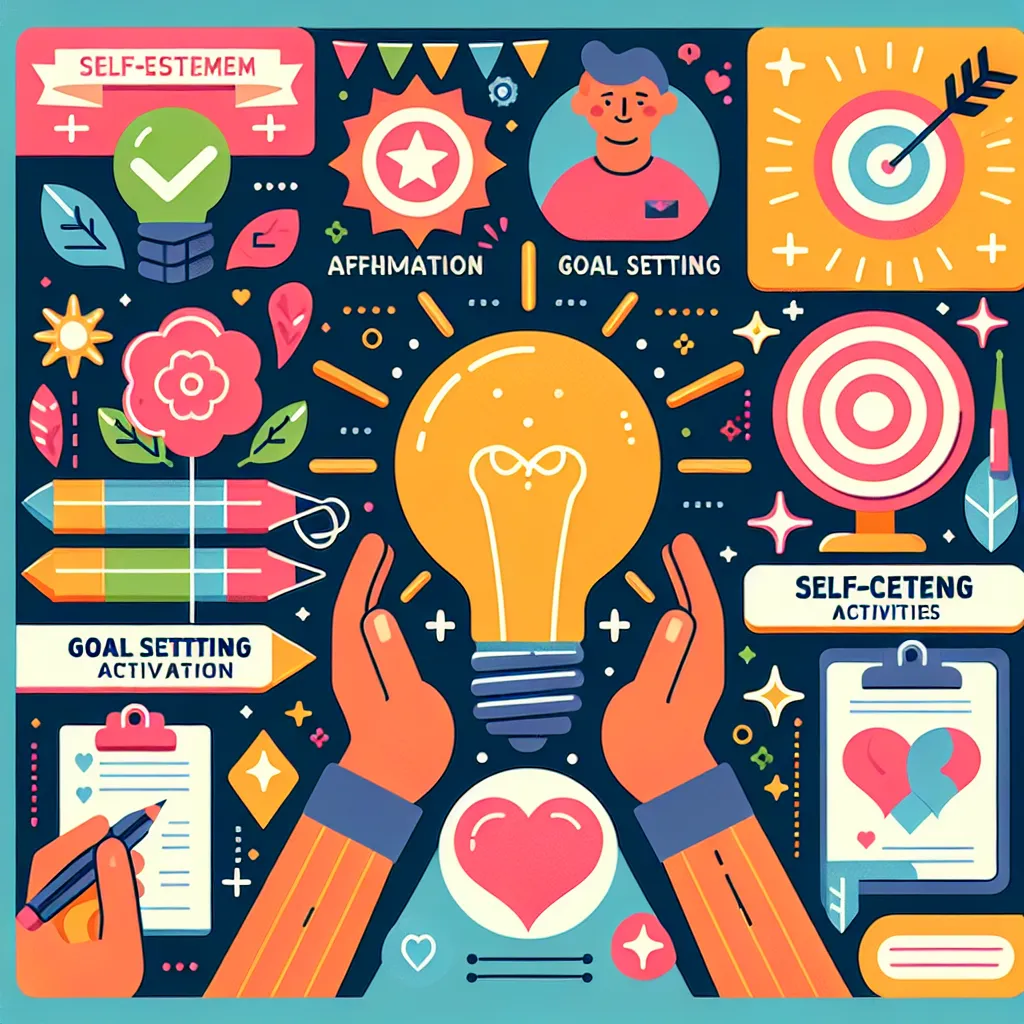The IELTS Reading section is a crucial component of the test, assessing your ability to comprehend and analyze written English. In this article, we’ll focus on a topic that has been increasingly prevalent in recent years: self-esteem. Based on data analysis from various IELTS resources, questions related to mental health and personal development have become more common in the Reading test. Given the current emphasis on well-being and personal growth, it’s likely that topics like “Tips for boosting self-esteem” will continue to appear in future IELTS exams.
Let’s dive into a practice Reading passage on this subject, followed by questions and a detailed analysis to help you prepare effectively for your IELTS test.
Practice Reading Passage
The Power of Self-Esteem: Unlocking Your Potential
Self-esteem, the cornerstone of personal development, plays a crucial role in shaping our lives and relationships. It’s not just about feeling good about ourselves; it’s about recognizing our worth and potential. In today’s fast-paced world, where social media and constant comparisons can erode our self-confidence, nurturing a healthy self-esteem has become more important than ever.
Psychologists define self-esteem as the overall sense of personal value and self-worth. It’s the foundation upon which we build our identity and navigate life’s challenges. People with high self-esteem tend to have better mental health, more fulfilling relationships, and greater success in their personal and professional lives. Conversely, low self-esteem can lead to anxiety, depression, and a host of other mental health issues.
So, how can we boost our self-esteem? Here are some proven strategies:
-
Practice self-compassion: Treat yourself with the same kindness and understanding you would offer a good friend. Acknowledge that everyone makes mistakes and that they’re opportunities for growth, not reasons for self-criticism.
-
Set realistic goals: Challenge yourself, but ensure your goals are attainable. Breaking larger objectives into smaller, manageable tasks can help you build confidence through regular achievements.
-
Cultivate positive relationships: Surround yourself with supportive, encouraging people who appreciate you for who you are. Limit time spent with those who consistently bring you down or undermine your self-worth.
-
Develop your strengths: Identify your talents and skills, then find ways to use and improve them. Engaging in activities you’re good at can boost your confidence and overall sense of competence.
-
Practice gratitude: Regularly acknowledging the good things in your life can shift your focus from what you lack to what you have, fostering a more positive self-image.
-
Challenge negative self-talk: Be aware of your inner critic and actively counteract negative thoughts with more balanced, realistic ones. Over time, this can reshape your thought patterns and boost self-esteem.
-
Take care of your physical health: Regular exercise, a balanced diet, and adequate sleep can significantly impact your mood and self-perception. Physical well-being often translates to improved mental health.
-
Learn new skills: Acquiring new knowledge or abilities can enhance your sense of competence and open up new opportunities for growth and achievement.
-
Practice assertiveness: Learn to express your needs, opinions, and feelings in a respectful, direct manner. This can improve your relationships and strengthen your sense of self-worth.
-
Engage in acts of kindness: Helping others not only benefits them but can also increase your own sense of purpose and value.
It’s important to remember that building self-esteem is a gradual process. It requires patience, consistency, and a willingness to challenge long-held beliefs about oneself. While external validation can provide temporary boosts, true self-esteem comes from within. It’s about developing a deep-seated belief in your own worth, regardless of external circumstances or others’ opinions.
In conclusion, boosting self-esteem is a journey of self-discovery and personal growth. By implementing these strategies and committing to ongoing self-improvement, you can develop a robust sense of self-worth that will serve as a foundation for a happier, more fulfilling life. Remember, you are worthy of love, respect, and success – and it all starts with believing in yourself.
 Boosting self-esteem strategies
Boosting self-esteem strategies
Questions
Multiple Choice
-
According to the passage, self-esteem is:
A) Only about feeling good about ourselves
B) The cornerstone of personal development
C) Not important in shaping our relationships
D) Easily maintained in today’s world -
People with high self-esteem tend to have:
A) More anxiety and depression
B) Fewer fulfilling relationships
C) Better mental health and more success
D) Less potential for personal growth -
Which of the following is NOT mentioned as a strategy to boost self-esteem?
A) Practicing self-compassion
B) Setting unrealistic goals
C) Cultivating positive relationships
D) Challenging negative self-talk
True/False/Not Given
-
Self-esteem is defined by psychologists as the overall sense of personal value and self-worth.
-
Low self-esteem always leads to better professional success.
-
Building self-esteem requires patience and consistency.
-
External validation is the most important factor in developing true self-esteem.
Matching Headings
Match the following headings to the correct paragraphs in the passage:
A. The importance of self-esteem
B. Defining self-esteem
C. Strategies for boosting self-esteem
D. The gradual nature of self-esteem development
- Paragraph 2: ____
- Paragraph 3: ____
- Paragraph 4: ____
- Paragraph 5: ____
Summary Completion
Complete the summary below using words from the box.
gradual external journey consistency temporary beliefs
Building self-esteem is a (12) process that requires patience and (13) . While (14) validation can provide (15) boosts, true self-esteem comes from within. It involves challenging long-held (16) about oneself and embarking on a (17) of self-discovery and personal growth.
Answer Key and Explanations
-
B
Explanation: The passage states, “Self-esteem, the cornerstone of personal development, plays a crucial role in shaping our lives and relationships.” -
C
Explanation: The text mentions, “People with high self-esteem tend to have better mental health, more fulfilling relationships, and greater success in their personal and professional lives.” -
B
Explanation: Setting unrealistic goals is not mentioned as a strategy. The passage actually suggests setting “realistic goals” as a way to boost self-esteem. -
True
Explanation: The passage directly states, “Psychologists define self-esteem as the overall sense of personal value and self-worth.” -
False
Explanation: The passage suggests the opposite, stating that high self-esteem is associated with “greater success in their personal and professional lives.” -
True
Explanation: The text explicitly states, “It’s important to remember that building self-esteem is a gradual process. It requires patience, consistency…” -
False
Explanation: The passage states, “While external validation can provide temporary boosts, true self-esteem comes from within.” -
B
-
A
-
C
-
D
Explanations:
- Paragraph 2 defines self-esteem.
- Paragraph 3 discusses the importance of self-esteem.
- Paragraph 4 lists strategies for boosting self-esteem.
- Paragraph 5 emphasizes the gradual nature of developing self-esteem.
- gradual
- consistency
- external
- temporary
- beliefs
- journey
Explanations: These words complete the summary accurately based on the information provided in the last two paragraphs of the passage.
Common Mistakes to Avoid
-
Misinterpreting “Not Given” answers: Remember, if the information is not explicitly stated in the passage, it’s “Not Given,” even if it seems logical or true in real life.
-
Overlooking keywords: Pay close attention to words like “always,” “never,” or “sometimes” in both the questions and the passage. These can change the meaning significantly.
-
Falling for distractors: In multiple-choice questions, some options may be partially correct but not the best answer. Always choose the most complete and accurate option.
-
Ignoring context: When matching headings or completing summaries, consider the broader context of the paragraph or passage, not just individual sentences.
-
Time management: Don’t spend too much time on difficult questions. If you’re unsure, make an educated guess and move on.
Vocabulary Focus
- Cornerstone (noun): /ˈkɔːnəstəʊn/ – a fundamental or essential part
- Erode (verb): /ɪˈrəʊd/ – gradually destroy or diminish
- Cultivate (verb): /ˈkʌltɪveɪt/ – try to acquire or develop (a quality, sentiment, or skill)
- Assertiveness (noun): /əˈsɜːtɪvnəs/ – confident and forceful behavior
Grammar Spotlight
Pay attention to the use of conditional structures in the passage, such as:
“While external validation can provide temporary boosts, true self-esteem comes from within.”
This sentence uses a concessive conditional structure, indicating a contrast between two ideas. The structure is:
While + [clause], [main clause]
This structure is useful for expressing ideas that are true but contrast with each other.
Tips for High Scores in IELTS Reading
-
Practice active reading: Engage with the text by underlining key points and making mental notes as you read.
-
Improve your vocabulary: Regularly learn new words and their contextual usage to understand complex texts better.
-
Time management: Allocate your time wisely among the three sections of the Reading test.
-
Skim and scan effectively: Use these techniques to quickly locate specific information in the passage.
-
Read the questions carefully: Understand exactly what each question is asking before searching for the answer.
-
Practice with various question types: Familiarize yourself with all possible question formats in the IELTS Reading test.
-
Develop your inference skills: Learn to understand implied meanings and draw conclusions from the text.
-
Stay calm and focused: Manage test anxiety by practicing under timed conditions and using relaxation techniques.
Remember, consistent practice and familiarity with various topics and question types are key to achieving a high score in IELTS Reading. Good luck with your preparation!
For more insights on related topics, check out our articles on the effects of social media on self-esteem and how to promote mental health through community engagement.


